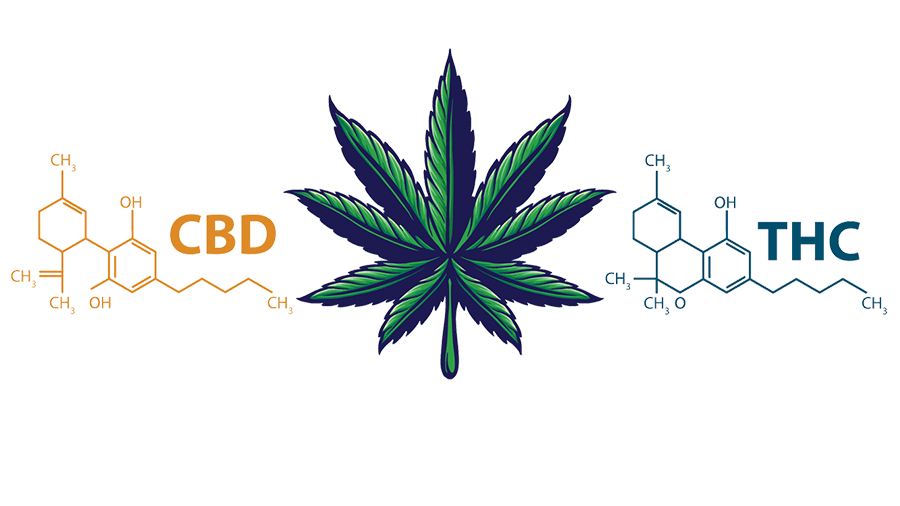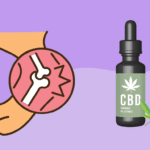Key takeaways:
- CBD has pain-relieving properties that may help with various types of pain, including inflammatory, chronic, neuropathic, arthritis, and cancer pain.
- The strongest evidence comes from studies using preparations with significant amounts of THC. More high-quality studies of pure CBD and particularly full-spectrum (high-CBD, low-THC) formulations are needed.
- CBD is relatively safe and has few and minor side effects. However, it may interact with some prescription drugs, so it’s important to consult a doctor before taking CBD.
Chronic pain is notoriously difficult to treat because prescription drugs don’t always work and can have serious side effects.
That’s why more and more people are turning to safer alternatives like cannabis and cannabidiol (CBD). In fact, surveys suggest that pain relief is among the most common reasons for CBD use (1, 2).
The good news is that there’s growing evidence that CBD may help relieve various types of pain. However, more rigorous clinical studies are needed before CBD is accepted as a reliable treatment.
Here’s what the studies tell us about using CBD for pain, how it works, the right dosage, and other tips.
Table of Contents
CBD and Pain: What Does the Research Say?
There are more human studies each year showing that CBD may help relieve various types of pain, including inflammatory, chronic, neuropathic, arthritis, and cancer pain.
However, most of these studies lack the rigorous design needed for reliable, high-quality findings.
Another issue is that most studies use purified CBD, which is as much as four times less effective than full-spectrum CBD preparations that contain other synergistic cannabinoids, terpenes, and flavonoids.
There are also multiple studies showing positive results with Sativex, a 1:1 pharmaceutical extract of CBD and THC. However, the large amount of THC makes it difficult to say how much of the pain relief comes from CBD.
Human Studies of CBD for Pain
Here’s a summary of the key findings:
- A 2020 placebo-controlled study looked at the effects of CBD in 29 people with peripheral neuropathy, a type of neuropathic (nerve-related) pain that usually affects the hands and feet. CBD oil was applied topically, improving pain and cold and itching sensations (3).
- Another 2004 placebo-controlled study looked at the effects of whole-plant cannabis extracts of THC, CBD, and a 1:1 formulation in 24 chronic pain patients (mostly multiple sclerosis). The extracts were applied sublingually (under the tongue) and reduced pain and spasticity (a symptom of MS), unlike the placebo (4).
- A 2019 study looked at the effects of CBD capsules in 97 chronic pain patients who used opioids. This study is particularly important because it tested full-spectrum CBD, which is more potent than pure CBD and rarely studied by researchers. Over half (53%) of the patients reduced or totally stopped using opioids within eight weeks, with 94% reporting better quality of life, including improvements in pain and sleep (5).
- A 2017 study of girls vaccinated against the human papillomavirus reported improved body pain symptoms after taking full-spectrum CBD oil (150 mg/ml CBD daily maximum) (6).
- A 2021 placebo-controlled trial of CBD-rich cannabis oil (160 mg CBD/40 mg THC per ml) improved general well-being and abdominal pain in 56 Crohn’s disease sufferers (7).
- A 2018 study of elderly kidney transplant patients treated with 50-150 mg of CBD twice daily for three weeks reported improvements in pain in 6 out of 7 patients (8).
- One 2020 paper also discussed two case reports (detailed reports of individual patients) of people with lower back pain who experienced relief with a topical CBD cream (9).
Finally, a handful of human studies found that CBD had no effects on pain, possibly due to low dosage or other factors (10).

Patient Surveys of CBD for Pain
Given the relative lack of high-quality studies looking at CBD and pain, patient surveys can offer helpful insights:
- A 2022 survey of 428 arthritis patients who used CBD found that 83% experienced less pain and 66% improved physical function, with an average 44% reduction in pain. The majority (60.5%) also reduced or stopped taking other pain medications (11).
- A 2020 study out of New Zealand surveyed 400 patients taking CBD oil, finding significant improvements in self-reported quality of life and chronic pain (12). Another 2020 survey of 58 palliative care patients in Florida reported that 24% used CBD, with half reporting reduced pain (13).
- A 2021 survey of 253 patients suffering from chronic pain found that the majority (62%) tried a CBD product, with 59% reporting reductions in pain and 68% saying they reduced their pain medication usage (14).
- Another 2021 survey of 2701 people with fibromyalgia and other chronic pain conditions reported that 29% used CBD in the past and 32% currently use it, with slight to serious improvements in pain and other symptoms (15).
Studies of Sativex (CBD plus THC)
Sativex is a pharmaceutical drug that combines CBD and THC at a 1:1 ratio. It’s applied as a sublingual spray, which is similar to how you’d use CBD oil. Sativex has shown positive results in multiple pain-related studies:
- In a 2006 study of 75 rheumatoid arthritis patients, Sativex resulted in reduced pain and disease activity (16)
- In a 2015 study of 234 people with peripheral neuropathic pain, Sativex treatment led to reduced pain severity, with more than half experiencing a 30% or greater improvement (17)
- A 2017 review of multiple studies of Sativex in multiple sclerosis (MS) patients concluded that it’s effective in improving muscle spasticity and quality of life (18)
There’s also some evidence that Sativex may help with cancer-related pain. A 2010 placebo-controlled study of 177 patients with advanced cancer pain who weren’t getting sufficient relief from opioids compared the effects of pure THC, a 1:1 CBD and THC formula, and a placebo.
Only the combination treatment resulted in significant pain relief over placebo, suggesting that CBD works in synergy with THC (19). A follow-up study of 43 patients in 2013 reported that the 1:1 treatment was tolerated well and remained effective during long-term use (5 weeks and more) (20).
Finally, a 2012 study of Sativex in chronic cancer pain sufferers reported improvements in some patients (21).

Animal Studies of CBD for Pain
The bulk of what we know about CBD’s potential pain-relieving effects comes from animal studies. Here’s a quick look at the key findings:
- In a 2018 placebo-controlled study of dogs with osteoarthritis, CBD oil improved pain and activity levels (22)
- In a 2016 study of rats with arthritis, transdermal CBD gel improved pain and inflammation without side effects (23)
- A 2015 study in mice found that CBD strengthened the effects of the painkiller morphine (24)
- CBD protected mice against chemotherapy-induced neuropathic pain in a 2014 study (25)
- In a 2021 study of rats, CBD reduced both inflammatory and non-inflammatory pain, with 40 mg/kg doses providing similar relief to 100 mg/kg doses of the common painkiller ibuprofen (26)
- CBD protected mice against diabetic neuropathic pain in a 2010 study (27)
In summary, CBD holds serious promise in treating different types of pain, but more evidence from high-quality randomized controlled trials (RCTs) — the gold standard of medical research — is needed.
As concluded by a trio of esteemed researchers, including Raphael Mechoulam, the chemist who discovered THC:
There is obviously an abundance of in vitro and preclinical in vivo evidence for the efficacy of CBD to treat many human medical conditions but few human clinical trials to support this evidence. It is critical that these claims are evaluated in high-quality human RCTs (10).
CBD: What Does the Science Say?
How Does CBD Work?
Although we don’t yet have the full picture, CBD appears to interact with multiple bodily systems that regulate pain and inflammation.
CBD and the ECS
One way CBD may help with pain is through the endocannabinoid system (ECS), which is made up of cannabinoid receptors, endocannabinoids, and special enzymes.
This crucial system regulates many important processes, including immunity, brain function, metabolism, and pain perception, to maintain a healthy state of balance called homeostasis (28).
In fact, research suggests that the ECS regulates every stage of pain-processing pathways, with endocannabinoids working much like a “brake” that reduces the sensation of pain and provides relief (29).
That’s why multiple animal studies have reported that suppressing enzymes that break down the two main endocannabinoids, anandamide and 2-AG, may reduce pain (30, 31).
As it happens, CBD also suppresses one of these enzymes — FAAH — which breaks down anandamide (32). In doing so, CBD may elevate anandamide levels, promoting its anti-inflammatory and pain-relieving effects (33, 34).
Other Mechanisms
Studies suggest that CBD can also help with pain by influencing other inflammation and pain-regulating molecules, including: (35)
- Glycine receptors
- PPARγ receptors
- TRP channels
- Serotonin 5HT1a receptors, which may be involved in neuropathic pain
- “Orphan” receptors like GPR3 and GPR6
How to Best Use CBD for Pain
There are several factors to consider when using CBD for pain. First and foremost, I always recommend opting for full-spectrum CBD products instead of those containing pure CBD.
Full-spectrum CBD extracts carry many cannabinoids, terpenes, flavonoids, and other beneficial molecules that work in synergy and are widely considered superior to pure CBD (36).

Choosing the Right Administration Route
You should also choose the best way to take CBD for your particular kind of pain: oil, oral products (capsules & gummies), vapes, or topicals.
CBD oil is generally best for whole-body relief because it’s absorbed well, makes it easy to change the dose, works relatively quickly (15-45 min), and has long-lasting effects (about 6-8 hours) (28).
Vaping can be a decent alternative if you want immediate relief, but the effects last shorter (2-4 hours. Meanwhile, topical products are ideal for localized relief because they only work where you apply them.
The last option is capsules, gummies, and other edible products, which are convenient and long-lasting but not ideal because the body poorly absorbs them. although you can improve this by taking them alongside a fat-containing meal (37).
You can also combine multiple products (like CBD oil and a balm) for optimal relief.
Dosage: How Much CBD to Take
CBD dosage is different for every individual because it depends on body weight, age, genetics, the type of product you’re taking, and other factors.
Your best bet is to “start low and go slow” (38). If you’re a beginner, 10-15 mg is a good starting point. Wait and watch the effects over the next two hours. If you don’t feel anything, you can slowly raise the dose until you find the amount that provides the desired relief.
Another option is to follow the dosage recommended by your CBD product.
CBD Safety & Side Effects
Decades of research have shown CBD to be a relatively safe compound with minor side effects (1). The World Health Organization (WHO) also recognized it as “generally well tolerated with a good safety profile” in a 2018 review (39).
Common side effects of CBD include tiredness, lightheadedness, low blood pressure, and dry mouth (40). There’s also some evidence that CBD may interact with certain prescription medications. For example, it may increase the concentrations of opioids and work synergistically with morphine (24).
CBD’s side effects have been mostly reported by studies using large oral doses of purified CBD, which isn’t how most people use it. Still, I recommend talking to your doctor before using CBD, especially if you’re taking prescription medications.
CBD for Pain: Serious Potential
To sum up, research suggests that CBD may help relieve different types of pain. However, more high-quality evidence is needed to confirm CBD’s potential.
If you’re interested in trying CBD for pain relief, I recommend using a quality full-spectrum CBD oil for body-wide issues and a topical product for localized concerns.
CBD’s relative safety makes it an attractive alternative to prescription pain medications, and opioids in particular, which are notorious for their addictive potential.
As noted by leading cannabis and CBD researchers:
There is significant interest in determining whether medical cannabis, or particular cannabinoids such as CBD, could replace opiates as analgesics or act as opioid-sparing compounds.
(10)
References
- Wheeler, Meghann, et al. “CBD (cannabidiol) product attitudes, knowledge, and use among young adults.” Substance use & misuse 55.7 (2020): 1138-1145.
- Fortin, Davide, et al. “Reasons for using cannabidiol: a cross-sectional study of French cannabidiol users.” Journal of Cannabis Research 3.1 (2021): 1-5.
- Xu, Dixon H., et al. “The effectiveness of topical cannabidiol oil in symptomatic relief of peripheral neuropathy of the lower extremities.” Current pharmaceutical biotechnology 21.5 (2020): 390-402.
- Wade, Derick T., et al. “A preliminary controlled study to determine whether whole-plant cannabis extracts can improve intractable neurogenic symptoms.” Clinical rehabilitation 17.1 (2003): 21-29.
- Capano, Alex, Richard Weaver, and Elisa Burkman. “Evaluation of the effects of CBD hemp extract on opioid use and quality of life indicators in chronic pain patients: a prospective cohort study.” Postgraduate medicine 132.1 (2020): 56-61.
- Palmieri, Beniamino, Carmen Laurino, and Maria Vadala. “Short-Term Efficacy of CBD-Enriched Hemp Oil in Girls with Dysautonomic Syndrome after Human Papillomavirus Vaccination.” The Israel Medical Association Journal: IMAJ 19.2 (2017): 79-84.
- Naftali, Timna, et al. “Oral CBD-rich cannabis induces clinical but not endoscopic response in patients with Crohn’s disease, a randomised controlled trial.” Journal of Crohn’s and Colitis 15.11 (2021): 1799-1806.
- Cuñetti, Leticia, et al. “Chronic pain treatment with cannabidiol in kidney transplant patients in Uruguay.” Transplantation proceedings. Vol. 50. No. 2. Elsevier, 2018.
- Eskander, Jonathan P., et al. “Cannabidiol (CBD) as a treatment of acute and chronic back pain: A case series and literature review.” J Opioid Manag 16.3 (2020): 215-8.
- Parker, Linda A., Erin M. Rock, and Raphael Mechoulam. “CBD: What Does the Science Say?.” (2022).
- Frane, Nicholas, et al. “Cannabidiol as a treatment for arthritis and joint pain: an exploratory cross-sectional study.” Journal of Cannabis Research 4.1 (2022): 1-13.
- Gulbransen, Graham, William Xu, and Bruce Arroll. “Cannabidiol prescription in clinical practice: an audit on the first 400 patients in New Zealand.” BJGP open 4.1 (2020).
- Highet, Bridget H., et al. “Tetrahydrocannabinol and cannabidiol use in an outpatient palliative medicine population.” American Journal of Hospice and Palliative Medicine® 37.8 (2020): 589-593.
- Schilling, Jan M., et al. “Cannabidiol as a Treatment for Chronic Pain: A Survey of Patients’ Perspectives and Attitudes.” Journal of pain research 14 (2021): 1241.
- Boehnke, Kevin F., et al. “Cannabidiol use for fibromyalgia: prevalence of use and perceptions of effectiveness in a large online survey.” The Journal of Pain 22.5 (2021): 556-566.
- Blake, David R., et al. “Preliminary assessment of the efficacy, tolerability and safety of a cannabis-based medicine (Sativex) in the treatment of pain caused by rheumatoid arthritis.” Rheumatology 45.1 (2006): 50-52.
- Hoggart, B., et al. “A multicentre, open-label, follow-on study to assess the long-term maintenance of effect, tolerance and safety of THC/CBD oromucosal spray in the management of neuropathic pain.” Journal of neurology 262.1 (2015): 27-40.
- Giacoppo, Sabrina, Placido Bramanti, and Emanuela Mazzon. “Sativex in the management of multiple sclerosis-related spasticity: An overview of the last decade of clinical evaluation.” Multiple sclerosis and related disorders 17 (2017): 22-31.
- Johnson, Jeremy R., et al. “Multicenter, double-blind, randomized, placebo-controlled, parallel-group study of the efficacy, safety, and tolerability of THC: CBD extract and THC extract in patients with intractable cancer-related pain.” Journal of pain and symptom management 39.2 (2010): 167-179.
- Johnson, Jeremy R., et al. “An open-label extension study to investigate the long-term safety and tolerability of THC/CBD oromucosal spray and oromucosal THC spray in patients with terminal cancer-related pain refractory to strong opioid analgesics.” Journal of pain and symptom management 46.2 (2013): 207-218.
- Portenoy, Russell K., et al. “Nabiximols for opioid-treated cancer patients with poorly-controlled chronic pain: a randomized, placebo-controlled, graded-dose trial.” The Journal of Pain 13.5 (2012): 438-449.
- Gamble, Lauri-Jo, et al. “Pharmacokinetics, safety, and clinical efficacy of cannabidiol treatment in osteoarthritic dogs.” Frontiers in veterinary science (2018): 165.
- Hammell, D. C., et al. “Transdermal cannabidiol reduces inflammation and pain‐related behaviours in a rat model of arthritis.” European Journal of Pain 20.6 (2016): 936-948.
- Neelakantan, Harshini, et al. “Distinct interactions of cannabidiol and morphine in three nociceptive behavioral models in mice.” Behavioural pharmacology 26.3 (2015): 304-314.
- Ward, Sara Jane, et al. “Cannabidiol inhibits paclitaxel‐induced neuropathic pain through 5‐HT1A receptors without diminishing nervous system function or chemotherapy efficacy.” British journal of pharmacology 171.3 (2014): 636-645.
- Yimam, Mesfin, et al. “Antinociceptive and anti-inflammatory properties of cannabidiol alone and in combination with standardized bioflavonoid composition.” Journal of Medicinal Food 24.9 (2021): 960-967.
- Toth, Cory C., et al. “Cannabinoid-mediated modulation of neuropathic pain and microglial accumulation in a model of murine type I diabetic peripheral neuropathic pain.” Molecular pain 6 (2010): 1744-8069.
- Boehnke, Kevin F., Winfried Häuser, and Mary-Ann Fitzcharles. “Cannabidiol (CBD) in Rheumatic Diseases (Musculoskeletal Pain).” Current Rheumatology Reports (2022): 1-9.
- Woodhams, Stephen G., et al. “The role of the endocannabinoid system in pain.” Pain control (2015): 119-143.
- Long, Jonathan Z., et al. “Selective blockade of 2-arachidonoylglycerol hydrolysis produces cannabinoid behavioral effects.” Nature chemical biology 5.1 (2009): 37-44.
- Ahn, Kay, et al. “Discovery and characterization of a highly selective FAAH inhibitor that reduces inflammatory pain.” Chemistry & biology 16.4 (2009): 411-420.
- Clapper, Jason R., et al. “Anandamide suppresses pain initiation through a peripheral endocannabinoid mechanism.” Nature neuroscience 13.10 (2010): 1265-1270.
- Rettori, Elisa, et al. “Anti-inflammatory effect of the endocannabinoid anandamide in experimental periodontitis and stress in the rat.” Neuroimmunomodulation 19.5 (2012): 293-303.
- Mlost, Jakub, Marta Bryk, and Katarzyna Starowicz. “Cannabidiol for pain treatment: focus on pharmacology and mechanism of action.” International journal of molecular sciences 21.22 (2020): 8870.
- Russo, Ethan B. “The case for the entourage effect and conventional breeding of clinical cannabis: no “strain,” no gain.” Frontiers in plant science (2019): 1969.
- Lucas, Catherine J., Peter Galettis, and Jennifer Schneider. “The pharmacokinetics and the pharmacodynamics of cannabinoids.” British journal of clinical pharmacology 84.11 (2018): 2477-2482.
- Larsen, Christian, and Jorida Shahinas. “Dosage, efficacy and safety of cannabidiol administration in adults: a systematic review of human trials.” Journal of clinical medicine research 12.3 (2020): 129.
- https://www.who.int/docs/default-source/controlled-substances/whocbdreportmay2018-2.pdf?sfvrsn=f78db177_2
- Huestis, Marilyn A., et al. “Cannabidiol adverse effects and toxicity.” Current neuropharmacology 17.10 (2019): 974-989.
- Balachandran, Premalatha, Mahmoud Elsohly, and Kevin P. Hill. “Cannabidiol interactions with medications, illicit substances, and alcohol: a comprehensive review.” Journal of general internal medicine 36.7 (2021): 2074-2084.

Gleb is a freelance writer from Vancouver, Canada specializing in CBD and cannabis. He’s read thousands of studies on CBD and other supplements, helping him translate complex science into plain language. Gleb has tried and reviewed dozens of CBD brands and products, written third-party testing reports, and knows the CBD industry inside and out. When not writing, he likes to kickbox, travel, and tell everyone how awesome intermittent fasting is.





